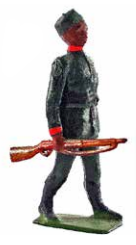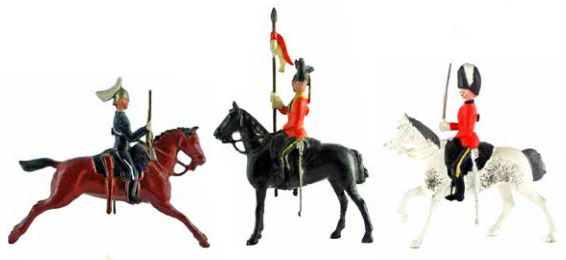
This article presents an array of questions (with answers provided on pages 40-41) that should
be fun for collectors of Britains to ponder. For more photographs, and to research the answers
to the questions posed, see my hard-cover, all-color editions of Soldiers of Greater Britain
(1893-1924), Armies of the World (1925-1941) and Regiments of All Nations (1946-1966).
Note that this article only deals with regularly catalogued sets, not Paris Office, noncatalogued
or second-grade production.
1. Which Britains sets represent cavalry regiments that Winston Churchill served in as a
lieutenant during the 1890s?
Set #8 depicted the 4th Hussars that young Winston served with in India. In 1898, Winston “pulled strings” to get himself attached to the 21st Lancers in the campaign to reconquer the Sudan. Kitchener forbade officers from supplying newspapers with eyewitness reports (in effect acting as war correspondents). Churchill circumvented this edict by writing private letters to the Morning Post’s owner (who published Churchill’s letters as the campaign proceeded). Prewar Set #94 offered the 21st
Lancers in the khaki Active Service uniforms they wore during their mounted charge against the Dervishes at Omdurman. Churchill attributed his survival to the ten-shot Mauser pistol he
took into battle (see My Early Life, A Roving Commission published by Churchill in 1930).
2. Which British regiment provided the basis for the uniform shown in Set #197, the 1st
Gurkha Rifles? This British infantry regiment and the Gurkhas fought alongside each other against mutinying Indian Sepoys in 1857.
The King’s Royal Rifle Corps had dark green uniforms with red facings. The 1st Gurkha Rifles shown in Set #197 adopted that uniform with Kilmarnock (pillbox) caps. The Gurkhas from Nepal fought bravely
alongside the 60th Rifles of the King’s Royal Rifle Corps during the Indian Mutiny of 1857. They were later often used on the Northwest Frontier against Afridi tribesmen. Ultimately ten regiments of Gurkhas were raised. The 1947 independence of India resulted in India keeping six of these
Gurkha regiments, while Great Britain retained four of them. To this day they are a valued part of the British Army, although reorganized in 1994 into one regiment consisting of two battalions.
3. Britains made an obvious error in its box labels for two allied sets during the 1930s. Were they A. the Italian Infantry of Sets 1435 and #1436, B. the Russian Infantry of Set #133 and the Cossacks of Set #136, C. the Prussian Hussars of Set #153 and the Prussian Infantry of Set #154, or D. the West Point Cadets of Sets #226 and #299?
Britains added inaccurate wording in the 1930s to the Whisstock box labels for Sets #133 and #136.It read “United States of Soviet Russia” instead of the correct “Union of Soviet Socialist Republics”.
4. What four cavalry sets were issued by Britains with green uniforms?
Britains issued the following mounted sets with green uniforms: #66 1st Bombay Lancers with white breeches (later retitled the 13th Duke of Connaught’s Own Indian Lancers and transformed to dark blue kurtas about 1950), #83 Middlesex Yeomanry, #136 Russian Cossacks, and #170 Greek Cavalry. Set #2028 Soviet Cavalry had green tunics but blue breeches. For a nice photograph of Set #83, Middlesex Yeomanry, see the front cover of my Soldiers of Greater Britain book.
5. What were the postwar Britains sets that contained a soldier carrying a Bren gun at the trail?
Troops with a Bren Gun carried at the trail were included in postwar Sets #1858 British Infantry in Battledress, #2010 Airborne “Red Devils” Infantry, #2011 with its Royal Air Force Regiment component, and #2155 United Nations Infantry.

6. Only one Britains set featured men holding “Tommy Guns” (Thompson submachine guns). Can you identify it? (It did not include Al Capone.)
The only set with men holding “Tommy guns” (Thompson submachine guns) was Set #1898,
British Infantry with Rifles and Tommy Guns.

7. What was the only set that included figures running at the trail after 1952? Was it A. the
King’s Royal Rifle Corps in Set #98 , B. the Rifle Brigade of Set #2091, C. the Swedish Infantry of Set #2035 or D. the Royal Marines in Set #1284?
The Royal Marines in Set #1284 were the only running at the trail figures obtainable from Britains after 1952 (the last year for Set #98 King’s Royal Rifle Corps.)
8. Now for a very challenging question: what were the only two Britains sets running at the trail wearing khaki uniforms?
The two Britains sets running at the trail wearing khaki uniforms were the first version of Set #96 the York and Lancaster Regiment with smooth tropical service helmets (circa 1899), and the Greek Infantry of Set #171.

9. Each type of British Cavalry (Dragoon Guards, Hussars, Lancers and Dragoons) had one regiment that varied from the rest by adopting a different uniform. Name those regiments, how they differed from the standard uniform, and their Britains set number?
The “exceptions to the rule” for regiments of British Cavalry are: the 6th Dragoon Guards with dark blue rather than red tunics (Set #106), the 11th Hussars with cherry-colored breeches instead of blue (Sets #12 and #182), the 16th Lancers with scarlet tunics instead of dark blue ones (Set #33), and the
2nd Dragoons or Royal Scots Greys with bearskin caps (Set #32).

10. There were many Britains sets that employed slung rifles. Single out which one of the following sets did not: Set #136 Russian Cossacks, the earliest version of Set #140 French Dragons (with separate plug-in carbines), #169 Italian Bersagliere, #186 Mexican Rurales, #1858 British Infantry in Battledress, #1918 Home Guard, #2010 Airborne Infantry (Red Devils), #2011 Royal Air Force Regiment, #2017 and #2037 Ski Troopers, #2031 Australian Infantry in Battledress, #2044 U.S. Air Corps, and #2155 United Nations Infantry.
Set #2031 Australian Infantry in Battledress held their rifles at the slope, not marching with slung rifles.
